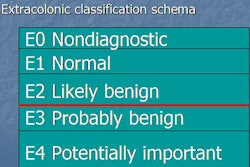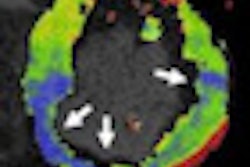Medicare doesn't cover most virtual colonoscopy exams, but the lack of reimbursement hasn't stopped more and more hospitals from offering the service, concludes a new study in the March Journal of the American College of Radiology. Between 2005 and 2009, the percentage of hospitals providing the service grew from 13% to more than 17%.
Among U.S. hospitals included in the survey, there was a statistically significant rise in the number of providers offering virtual colonoscopy (also known as CT colonography or CTC) every year, wrote Megan McHugh, PhD, of Northwestern University, and colleagues from the Health Research and Educational Trust and the National Cancer Institute.
"Although CTC is not yet widely accepted as a colorectal cancer screening tool for average-risk adults, anecdotally, it is clear that many hospitals in the U.S. have adopted the service," McHugh and her team wrote. "As policymakers and others consider ways to increase colorectal cancer screening, it is important to understand U.S. hospitals' readiness to offer CTC and the factors that facilitate or impede adoption" (JACR, March 2011, Vol. 8:3, pp. 169-174).
Key to the discussion is that CTC requires a coordinated system of delivery to ensure that patients can receive same-day colonoscopy if needed, they wrote.
The team sought to determine the extent to which U.S. hospitals provide virtual colonoscopy services, as well as the availability of conventional optical colonoscopy services at those same hospitals. The group also wanted to assess "factors that facilitate or impede hospitals' implementation of CTC," they wrote.
The study examined data on the provision of colorectal cancer screening services by nonfederal general hospitals for the years 2005 to 2008, based on American Hospital Association annual surveys.
In an effort to provide some data from 2009, the study team also conducted exploratory telephone interviews with representatives from radiology departments at nine hospitals, including six that provided CTC and three that did not.
"The small number of interviews reflects our desire to identify key issues surrounding the decision to adopt CTC yet not pose a burden on hospitals," the authors wrote. "We interviewed twice as many hospitals that offer CTC because we were also interested in exploring issues surrounding implementation of the technology."
The results showed that in 2008, 17% of hospitals offered CTC, compared with 13% in 2005.
In all, 50% of nonfederal general hospitals said they offered CTC in 2008, and of these, 69% also offered optical colonoscopy.
"Large hospitals, private nonprofit hospitals, hospitals located in the Northeast, nonrural hospitals, members of the Council of Teaching Hospitals and Health Systems, and hospitals that are affiliated with systems were more likely to offer the service than other hospitals," McHugh and colleagues wrote.
Although there was no clear pattern for providing CTC in terms of hospital financial status, those in the highest quartile were less likely to provide the service, while those in the second-highest quartile were most likely to offer CTC.
Factors motivating the adoption of CTC included:
- A desire to provide an alternative screening option for frail, elderly patients and patients with failed optical colonoscopy
- Long waits for optical colonoscopy
- Promising evidence on CTC published in peer-reviewed literature
All respondents said that the lack of CTC reimbursement was an important consideration.
"Respondents from the three hospitals that do not provide CTC all said that they had considered offering the service, but the lack of reimbursement for general screening and the cost of implementation were major barriers that prevented them from proceeding with implementation," the authors wrote.
Half of the hospitals providing CTC said they had to purchase CO2 insufflators or dedicated software for CTC but considered the costs minor.
Respondents from five of the six hospitals offering CTC said they performed fewer than 50 studies per year, primarily for patients with failed optical colonoscopy, most of which are eligible for third-party reimbursement for CTC, McHugh and colleagues wrote.
Hospitals providing CTC said it took fewer than six months between the decision to offer CTC and its implementation. Radiologists typically underwent training in a continuing medical education class that provided experience in more than 50 cases, but technologists tended to be trained on the job, the authors wrote.
As for limitations, the American Hospital Association data only indicate whether a hospital and its affiliated outpatient centers provide CTC; there is no information about procedure volume. In addition, the respondents may have had an inaccurate view of the hospital's CTC services, according to the authors. The interviews represent only a sample and are not generalizable.
"Widespread implementation of CTC, though, and its expansion to a broader group of patients, may be difficult under current reimbursement policies," McHugh and colleagues concluded. "The impact of Medicare's recent decision on future adoption of CTC is uncertain. Although more information related to procedure outcomes is needed, CTC's relatively easy implementation coupled with improved patient acceptance makes CTC a tool that holds promise for the future of colorectal cancer prevention."



















